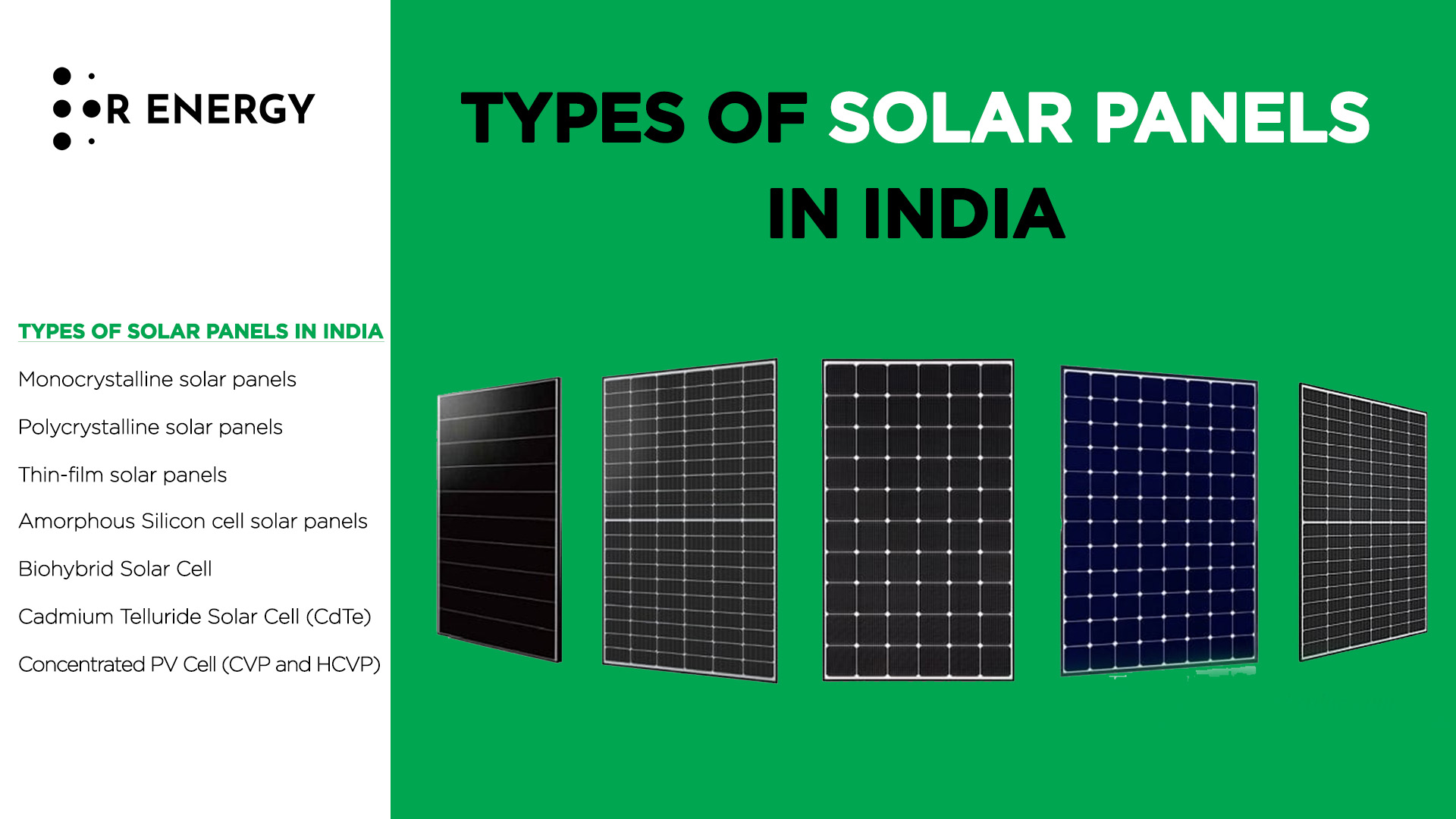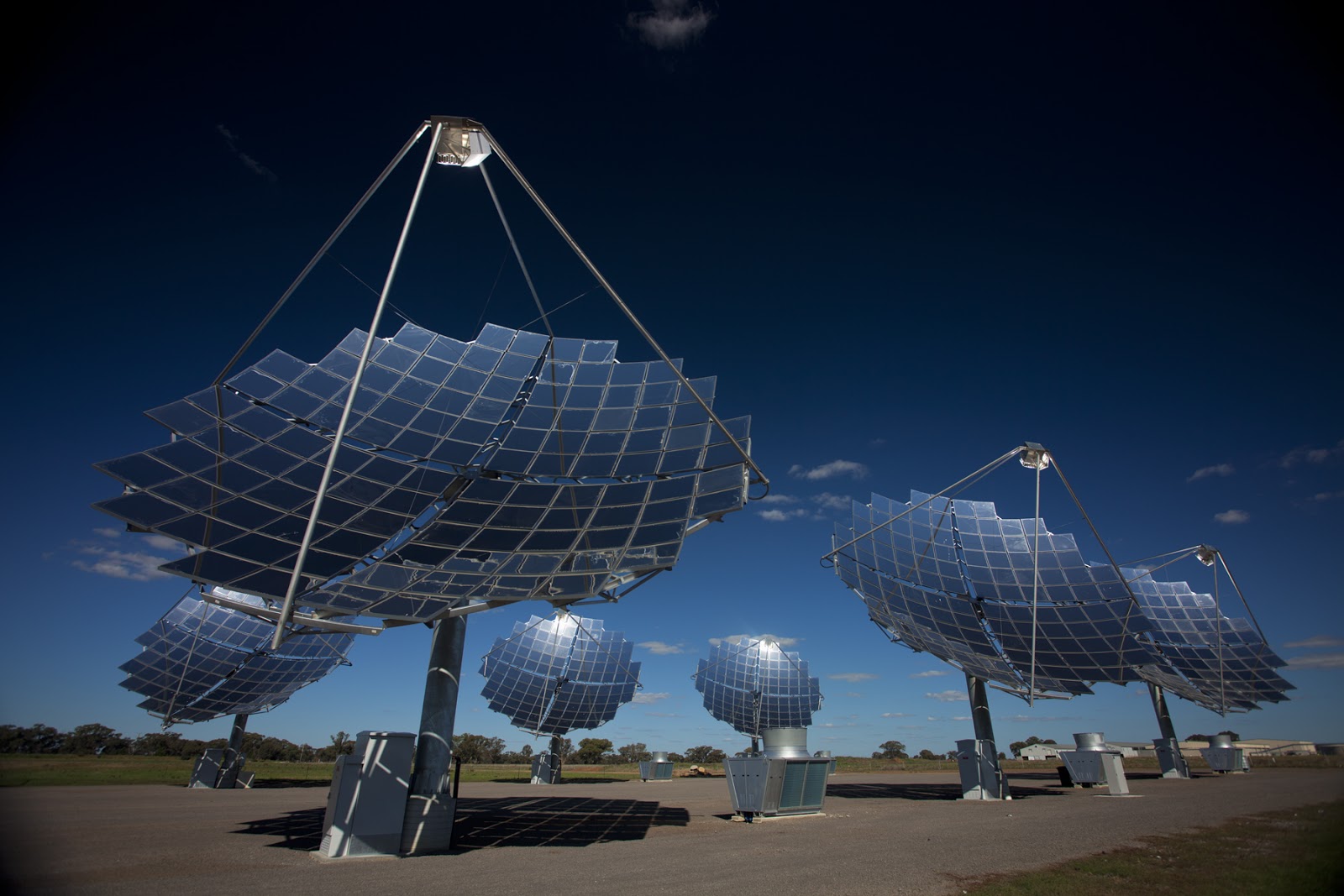Types of Solar Panels in India
In recent years, solar energy has gained significant momentum in India as an affordable and reliable source of renewable energy. The country’s government has launched several initiatives to promote the use of solar energy, including setting ambitious targets for solar capacity installation and providing incentives for solar panel installation. As a result, India has become one of the fastest-growing solar markets globally, with tremendous potential for further growth.
However, choosing the right type of solar panel is crucial to ensure that the solar system operates at maximum efficiency and provides a cost-effective solution for the consumer. The market is flooded with various types of solar panels, each with its unique features, advantages, and disadvantages. The choice of a solar panel depends on several factors, including geographical location, weather conditions, and electricity consumption patterns.
Selecting the right type of solar panel not only ensures maximum energy generation but also saves money on electricity bills in the long run. In this article, we will explore the different types of solar panels available in India and their respective advantages and disadvantages. Understanding the various types of solar panels and their suitability to different environments will help consumers make an informed decision and choose the best solar panel for their energy needs.
How to Categorize Different Types of Solar Panels?
With solar energy being the most affordable renewable energy source, it has become increasingly popular in recent years. However, the efficiency of solar panels is influenced by several factors, including the type of solar panel and the environment it is used in. This makes it crucial to understand the different types of solar panels available and how they are categorized.
One way of categorizing solar panels is by differentiating between single-junction and multi-junction solar panels. These types differ based on the number of layers on the solar panel that observe the sunlight. Single-junction solar panels consist of a single layer of a light-absorbing material, while multi-junction solar panels have multiple layers. Multi-junction solar panels are more efficient than single-junction solar panels as they can absorb a broader range of sunlight.
Another way of categorizing solar panels is by generation. This classification is based on the materials and efficiency of the solar panels. First-generation solar panels consist of crystalline silicon and have an efficiency of 15-20%. Second-generation solar panels are thin-film solar cells and have an efficiency of 7-13%. Third-generation solar panels, also known as advanced solar cells, are still under development and aim to have an efficiency of over 30%.
Apart from these two methods of categorization, solar panels can also be categorized based on their application, such as space-based solar panels, building-integrated solar panels, and concentrating solar panels.
In this article, we will discuss solar panels based on the classification by generation.
Solar panels based on 1st Generation solar cells
First-generation solar cells, also known as conventional solar cells, are the earliest type of solar cells that were developed and commercialized in the 1950s. These solar cells are made from crystalline silicon and are the most widely used type of solar cells today. The development of first-generation solar cells paved the way for the widespread adoption of solar energy as a viable source of renewable energy. Despite their success, first-generation solar cells have some limitations in terms of efficiency and manufacturing cost, which led to the development of second and third-generation solar cells. Nonetheless, first-generation solar cells remain an important technology in the field of solar energy and are still widely used today.
Monocrystalline solar panels
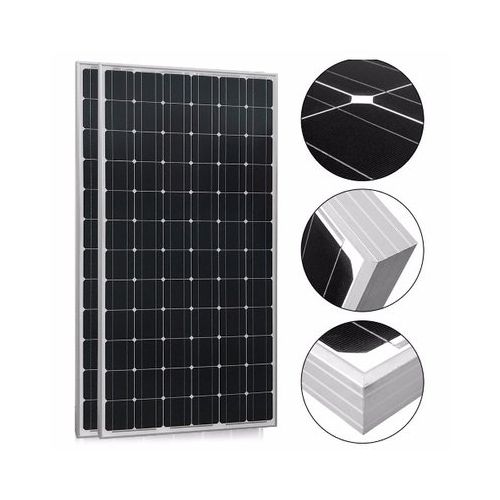
Monocrystalline solar panels, also known as single crystal panels, are a type of photovoltaic (PV) panel that converts sunlight into electricity. These solar panels are made of a single, high-purity silicon crystal and are recognized by their uniform dark look and rounded edges.
The manufacturing process of monocrystalline solar panels involves growing a single silicon crystal in a cylindrical shape, which is then sliced into thin wafers that form the individual cells of the panel. Monocrystalline solar panels are made of pure silicon crystal. These cells are cut to an octagonal shape, giving the panels their unique look and uniform color. They are easily identifiable by their black or dark blue color. The cells are then arranged in a series and connected to form the entire panel.
One of the major advantages of monocrystalline panels is their high-efficiency rate. They have one of the highest efficiency rates, with the newest ones reaching above 20%. Monocrystalline solar panels are highly efficient because they are made up of black solar cells in which the panel light interacts with a single crystal to produce electricity. This results in a high power output, occupying less space and lasting the longest.
Monocrystalline solar panels also have higher heat resistance, which means that their electricity production capacity is less affected by heat, and they produce electricity at a higher efficiency at high temperatures. This feature is highly beneficial for those living in areas with high temperatures.
Monocrystalline solar panels are more expensive than other panels because the manufacturing process of single-crystal silicon cells is complex. However, the high cost is offset by the long-term energy savings that these panels provide.
Another feature of monocrystalline solar panels is the technology known as Half Cut cells, where square-shaped cells are cut in half, allowing for twice the number of cells. The top half of the panel has all cells connected in one series, and the bottom half in another series. This feature allows the panel to continue power generation in the top half even if there is a shadow on the bottom half of the panel. Thus, the overall power generation from half-cut cells is higher in installations with partial shadow issues.
Polycrystalline solar panels
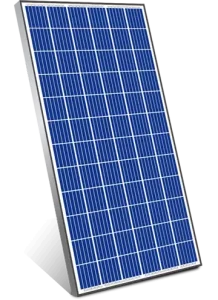
Polycrystalline solar panels are a popular type of solar panel used in India. They are easily distinguishable by their square shape, with angles that are not cut and a blue-speckled look. These panels are made by melting raw silicon, which is a faster and cheaper process compared to monocrystalline panels. The manufacturing process involves melting silicon fragments and pouring them into square molds. Once these crystals are cooled, they are sliced into thin wafers and assembled together to form a polycrystalline solar panel.
One advantage of polycrystalline solar panels is that they are less expensive than monocrystalline panels, making them more affordable for homeowners and businesses with large spaces. However, their efficiency is lower (around 14-16%) than monocrystalline panels because they are composed of multiple silicon crystals, which limits the space available for electrons to move. The panels also have a shorter lifespan and are affected by hot temperatures to a greater degree.
On the other hand, polycrystalline panels have some key features, such as their lower cost and simpler manufacturing process. The panels are identified by their square shape, with a blue hue and straight edges. They are also known as “multi-crystalline” panels.
Overall, the choice between polycrystalline and monocrystalline solar panels depends on the specific situation of the user. While polycrystalline panels offer a slightly higher space efficiency at a slightly lower price, the power outputs are basically the same as monocrystalline panels. However, new technologies are enabling the efficiency of polycrystalline panels to increase, making them a viable option for those seeking a cheaper alternative to monocrystalline panels.
Solar panels based on 2nd Generation solar cells
Second-generation solar cells refer to a new generation of solar cells that utilize advanced materials and technology to improve the efficiency of converting sunlight into electricity. Unlike first-generation solar cells, which are based on silicon wafers, second-generation solar cells use a range of new materials such as amorphous silicon, cadmium telluride, copper indium gallium selenide, and organic photovoltaic materials. These materials have unique properties that allow for the creation of thin-film solar cells that can be deposited on a variety of substrates, such as glass, plastic, or metal. The resulting solar cells are flexible, lightweight, and more efficient, making them an attractive option for a wide range of applications. Second-generation solar cells are still under development, but they hold great promise for the future of solar power.
Thin-film solar panels
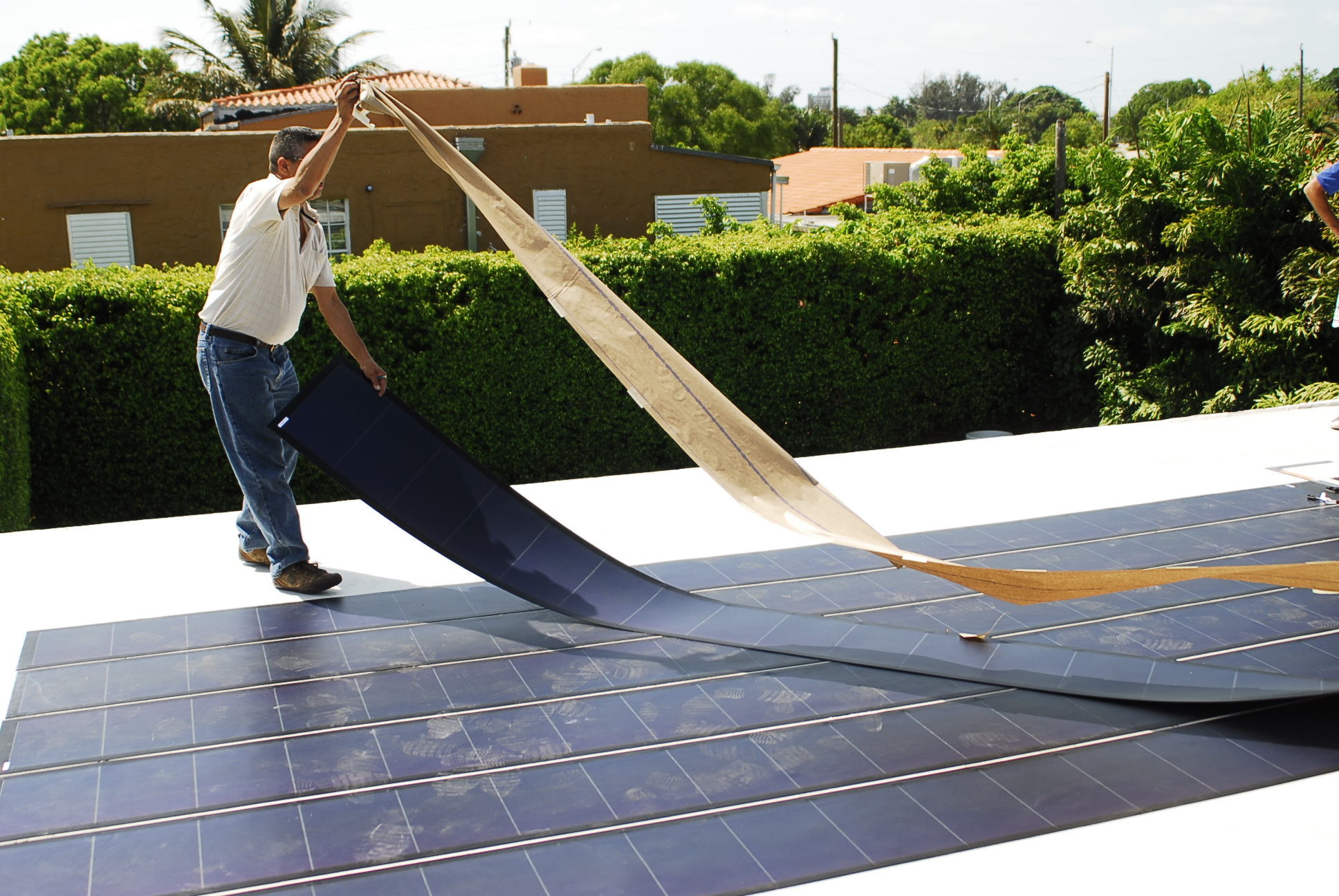
Thin-film solar panels are a second-generation and third-generation option for those looking for a less expensive solar panel option. They are manufactured by placing one or more films of photovoltaic material, such as silicon, cadmium, or copper, onto a substrate. They are flexible, making them suitable for alternative applications, and are less affected by high temperatures. However, they take up a lot of space and have a shorter lifespan than mono- and polycrystalline types of solar panels.
The main advantage of thin-film solar panels is their cost-effectiveness due to economies of scale making them cheaper to produce than other alternatives. They are lightweight and flexible, making them easy to install. However, they are less efficient compared to silicon crystalline panels, and their power capacity and efficiency are lower than mono- and polycrystalline panels.
Thin-film solar panels are usually manufactured using photovoltaic substances such as cadmium telluride (CdTe), amorphous silicon (a-Si), and copper indium gallium selenide (CIGS). CdTe solar panels have the lowest carbon footprint, while CIGS is the most efficient among other thin-film panels due to its higher absorption abilities.
Amorphous Silicon cell solar panels
![]()
Amorphous silicon solar cells, also known as A-Si solar cells, are a type of thin-film solar panel that is commonly used in small electronic devices such as pocket calculators and outdoor lighting fixtures. Here are some key points about amorphous solar panels:
A-Si solar panels use a triple-layered technology, which is the best of the thin-film variety. The layers are made of amorphous silicon, a non-crystalline form of silicon, which is deposited on a substrate such as glass or plastic.
Compared to crystalline silicon solar panels, A-Si solar cells have a lower efficiency rate of around 7%, which means they produce less electricity per unit area. However, they are also less expensive to produce, making them a more cost-effective option for certain applications.
A-Si solar panels are thin and flexible, which makes them ideal for use in curved surfaces or irregular shapes. They are also lightweight and easy to install and can be integrated into building materials such as windows and roofs.
While A-Si solar panels are not as efficient as crystalline silicon panels, they have some advantages such as better performance in low light conditions and less sensitivity to shading. They also have a longer lifespan than some other types of thin-film solar panels.
One of the main applications for A-Si solar panels is in outdoor lighting fixtures, where they can be used to power LED lights. They can also be used in small electronic devices and as part of larger solar arrays for commercial and industrial installations.
Overall, amorphous silicon solar cells are a versatile and cost-effective option for certain applications where space is limited or flexibility is required. While they may not be the most efficient solar panel technology available, they offer some unique advantages and are an important part of the renewable energy landscape.
Solar panels based on 3rd Generation solar cells
The third generation of solar cells refers to a new generation of photovoltaic (PV) technologies that aim to overcome the limitations of traditional solar cells, including efficiency, durability, and cost. Unlike the first and second generations, which are based on traditional silicon-based PV technology, the third-generation solar cells are based on a wide range of new materials and architectures, including organic and inorganic materials, nanotechnology, and bio-inspired designs. These new technologies have the potential to provide higher conversion efficiencies, lower costs, and greater durability compared to traditional solar cells, making them an attractive option for a wide range of applications, from large-scale power generation to portable electronics. Despite the promise of third-generation solar cells, however, there are still many technical and commercial challenges that must be addressed before these technologies can be widely adopted.
Biohybrid Solar Cell

The Biohybrid solar cell is still in the research phase and has been discovered by an expert team at Vanderbilt University. This cell is designed to emulate the natural process of photosynthesis by taking advantage of photosystem 1. By combining multiple layers of photosystem 1, the conversion from chemical to electrical energy becomes much more effective, up to 1000 times more efficient than first-generation solar panels. The materials used in this cell are similar to the traditional ones, but the multiple layers of photosystem 1 make it more efficient.
Cadmium Telluride Solar Cell (CdTe)
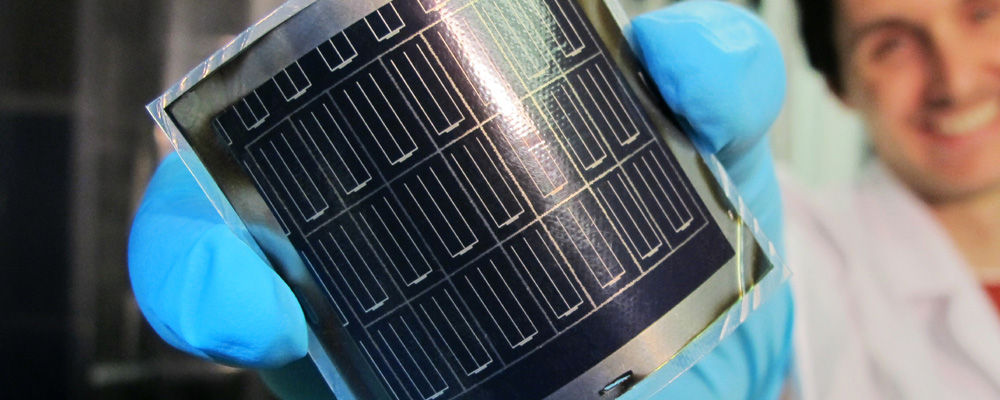
This photovoltaic technique uses Cadmium Telluride to produce solar cells at a relatively low cost and with a shorter payback time (less than a year). CdTe solar cells require the least amount of water for production among all solar energy technologies, which keeps the carbon footprint as low as possible. However, Cadmium Telluride is toxic if ingested or inhaled, making it a concern in Europe. Nevertheless, CdTe solar cells are still an efficient and cost-effective option for harnessing solar energy.
Concentrated PV Cell (CVP and HCVP)
Concentrated PV cells generate electrical energy just like conventional photovoltaic systems but with an efficiency rate of up to 41%, which is the highest among all photovoltaic systems. The efficiency of CVP cells is due to their curved mirror surfaces, lenses, and cooling systems that bundle the sun rays, increasing their efficiency. However, CVP solar panels can only be as efficient if they face the sun at a perfect angle, making it necessary to use a solar tracker inside the solar panel to follow the sun.
Power Capacity of Solar Panels
The power capacity of solar panels is measured in Watt peak (Wp), which is the peak DC power generated by the panel under standard testing conditions. The power capacity of different types of solar panels varies due to their efficiency, size, and construction. Here is a brief overview of the power capacity of different types of solar panels:
Monocrystalline solar panels: Monocrystalline solar panels have a power capacity range of 250 to 450 Wp, with the highest-rated panels having a capacity of up to 540 Wp.
Polycrystalline solar panels: These panels are made from multiple silicon crystals and have a lower efficiency than monocrystalline solar panels. Polycrystalline solar panels have a power capacity range of 250 to 370 Wp.
Thin-film solar panels: As they are the least efficient type of solar panels and have a lower power capacity than other types of panels. Thin-film solar panels are mainly used in large utility-scale power plants, as they are not suitable for residential or commercial applications. Their power capacity ranges from 120 to 300 Wp.
Market share of the solar panels
According to various industry reports, monocrystalline solar panels have the largest market share in India, accounting for over 36% of the total solar panel market. This is due to their high-efficiency rates, longer lifespan, and better performance in high temperatures compared to other types of solar panels.
Polycrystalline solar panels hold the second-largest market share in India, accounting for about 25% of the market. While they are less expensive than monocrystalline panels, they are less efficient and less durable.
Thin film solar panels have a small market share in India, accounting for approximately 10% of the market. These panels are lighter, more flexible, and less expensive than other types of solar panels. However, they have lower efficiency rates, require more space for installation, and have shorter lifespans.
Amorphous cell solar panels also have a small market share in India, accounting for approximately 4% of the market. These panels are made of non-crystalline silicon and are generally used in small applications such as calculators and watches due to their lower efficiency rates.
It’s worth noting that the market share of these types of solar panels can vary depending on factors such as government policies, incentives, and technological advancements. However, monocrystalline and polycrystalline solar panels are currently the most commonly used types of solar panels in India due to their higher efficiency rates and longer lifespan.
What type of panel is best for your installation?
Choosing the right type of solar panel for your installation depends on several factors. Monocrystalline panels are the most efficient and have the highest power output, making them suitable for higher-capacity solar plants in smaller areas. If you have a high electricity bill and limited space, monocrystalline panels can help you install up to 50-60% higher capacity solar plants within the same area. Although they have a higher upfront cost, they will be more beneficial in the long run by reducing your electricity bills significantly.
Read More: How to choose right Solar Panel for your Home
Polycrystalline panels, on the other hand, are a good choice if you have sufficient rooftop area available and want to keep costs lower. Additionally, they are currently the only option for availing government subsidies, which are available for residential solar panels manufactured within India. Indian manufacturers currently only supply polycrystalline cells for projects to be installed under government subsidy, as monocrystalline cell manufacturing has not yet started in India.
Thin-film solar panels are not typically used for residential or domestic installations due to their shorter lifespan. They are more commonly used in larger utility-scale power plants. Ultimately, the choice of solar panel for your installation will depend on your specific needs and available resources. It’s always best to consult with a professional installer to determine the best type of solar panel for your installation.
Conclusion
In conclusion, India has a variety of solar panels available for installation including monocrystalline, polycrystalline, and thin-film. When choosing a solar panel, it is important to consider factors such as efficiency, power output, available installation area, and upfront cost. Monocrystalline panels are best suited for higher-capacity solar plant installations in smaller areas, while polycrystalline panels are more cost-effective and are currently the only option for availing government subsidies in India. Thin-film solar panels are not commonly used for residential installations due to their lower life expectancy.
The future of solar energy in India looks promising, as the government is committed to expanding its renewable energy capacity to 450 GW by 2030, with solar energy being a major contributor. The government is also implementing various policies and initiatives to promote the use of solar energy, such as subsidies and tax exemptions for solar installations. With the growing demand for clean energy and the decreasing cost of solar technology, it is expected that the use of solar energy will continue to increase in India.
Read More: Top 10 Solar Panel Manufacturing Companies in India


